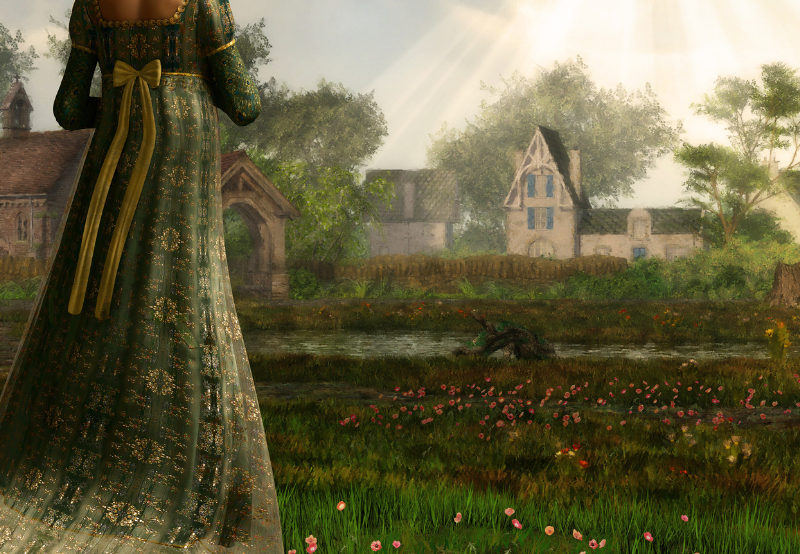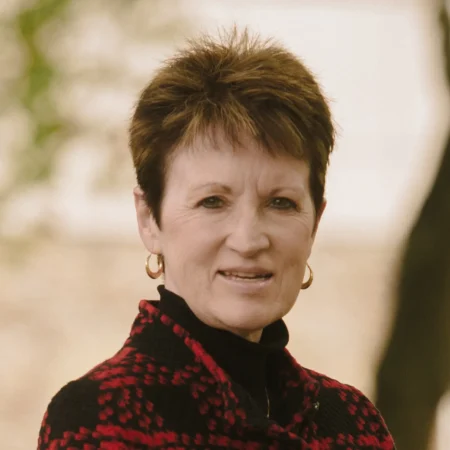In Chapter 3 of Pride and Prejudice, Mr. Bingley makes his first visit to Longbourn, the home of the Bennet family. He spends a few minutes in the library with Mr. Bennet, but he doesn’t even get a glimpse of the Bennet sisters, whom he really wanted to see:
He had entertained hopes of being admitted to a sight of the young ladies, of whose beauty he had heard much; but he saw only the father. The ladies were somewhat more fortunate, for they had the advantage of ascertaining from an upper window, that he wore a blue coat and rode a black horse.
I think this is a pretty good joke on Jane Austen’s part. By this point, we readers are starting to feel that we know the Bennet sisters a little bit. But when it comes to their physical appearance, we scarcely know more than Mr. Bingley does. We have heard from Mrs. Bennet that Elizabeth is only half as beautiful as Jane. We know already not to take Mrs. Bennet’s assessments at face value, but even if we believe Mrs. Bennet, we don’t know whether Jane is unusually beautiful or Elizabeth is unusually un-beautiful. And if Jane is unusually beautiful, what kind of beautiful is she? There are many ways to be physically beautiful.
Lydia, at the end of Chapter 2, reports that she is the tallest of the sisters. But in terms of physical description of any character, that’s all we get in the first two chapters. When the narrator mentions that Mr. Bingley had heard much of the Bennet sisters’ beauty, really that’s the first we’ve heard of it—and, to return to an earlier question, this is the first confirmation that Jane must be unusually beautiful.
When the sisters see from the upper window that Mr. Bingley wears a blue coat and rides a black horse, that’s not much of a description, but it is literally the most (and most reliable) description we have gotten of any character’s physical appearance in these first three chapters of the book.
It is amazing how little there is to look at in Pride and Prejudice. This may come as a surprise to anyone who is familiar with the movie versions of the story, which are so visually sumptuous. The clothes! The interiors! The English countryside! The city scenes! The dances! The soldiers!
Concrete, sensory descriptions of such things just aren’t that important to Jane Austen’s kind of storytelling. The physical facts of the world don’t matter nearly as the characters’ inner lives and their relational dynamics, which make themselves apparent in dialogue and mannerisms and manners.
If you have taken any of my writing classes, or read many of my Tuesday letters, you might be surprised to know how much I love Jane Austen. She breaks most of the rules that I try to teach my writing students. I am always trying to get my students to stay out of their characters’ heads as much as possible. Austen’s narrators are forever eavesdropping on characters’ thoughts and feelings. I warn my students against overly long speeches. Austen’s characters live for long speeches. And when her characters finally take a break from talking, Austen’s narrators typically launch into lengthy telling with very little showing. I push writers to populate their worlds with sensory images. Austen, as I have mentioned, gives the reader very little to look at.
And yet Pride and Prejudice works. It works so well that people are still crazy about it two centuries later. As I prepare to teach Writing with Jane Austen, I’m still trying to figure out how it works so well. The idea I keep coming back to is judgment: the book constantly engages the reader’s judgment. Within the first couple of pages, we have heard enough from Mrs. Bennet to have a pretty good idea of what to think of her, and we judge her every utterance accordingly. It’s the same with the younger Bennet girls, each of whom is ridiculous in her own way. The reader so closely aligns with Elizabeth’s judgment that the reader is hardly less shocked than Elizabeth herself when her judgment proves to have been faulty. In short, we use our judgment to navigate this story in very much the same way we use our judgment to navigate the world where we actually live and move and have our being.
Those storytelling rules I mentioned in the paragraph before last are really just guidelines to help the writer engage the reader’s judgment so that the reader feels she is engaging the story the way she engages the world. You don’t have a narrator following you around, telling you what other people are thinking, or what you ought to think about those people. You collect information through your senses, and then your judgment goes to work on that information.
But if you can engage the reader’s judgment as completely as Jane Austen does, you needn’t worry about anybody’s writing rules one way or another.
I recently finished teaching Writing with Caspian. The nice thing about walking writers through a Narnia book is that CS Lewis mostly follows the same writing rules that I try to teach. Jane Austen…not so much. Writing with Jane Austen, is going to be an adventure.








